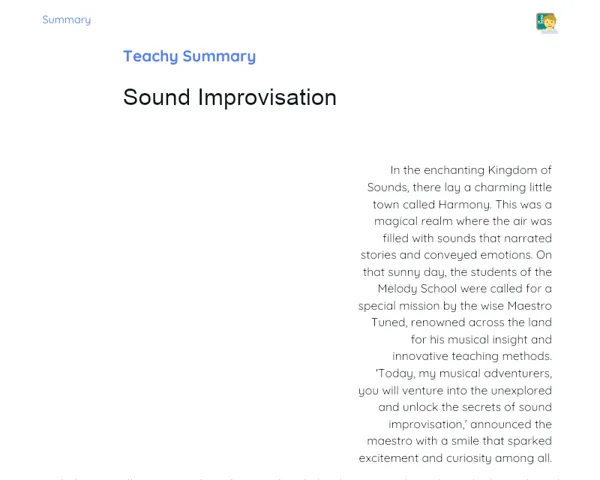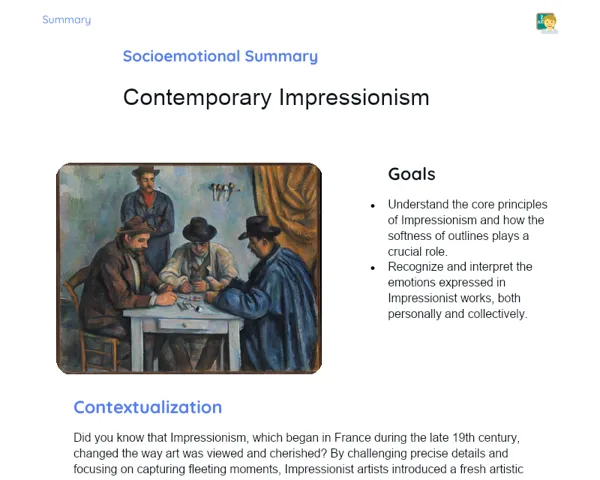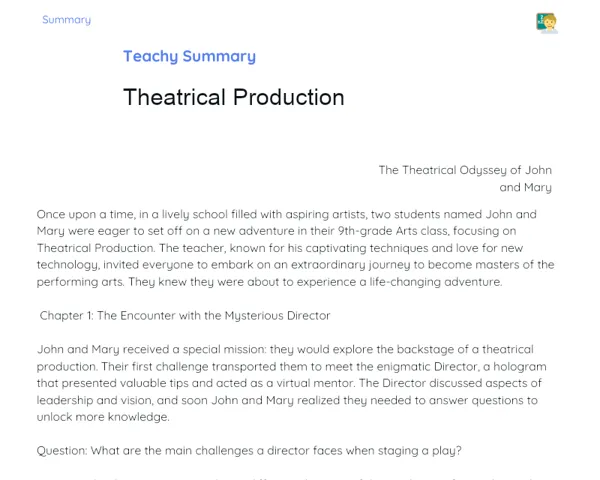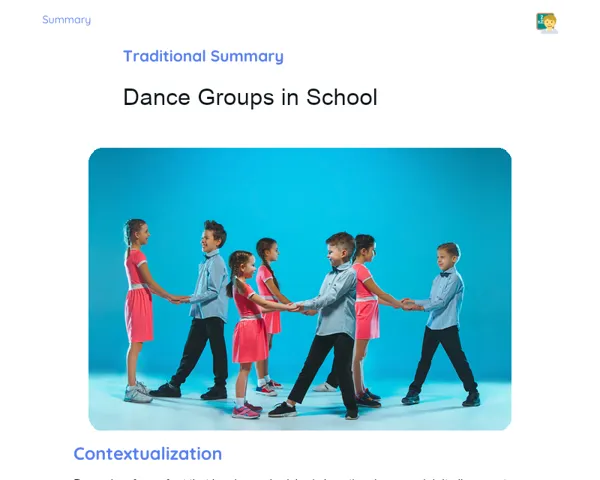Summary Tradisional | Postmodernism
Contextualization
Postmodernism is an artistic and cultural movement that came into being in the latter half of the 20th century, responding to the ideologies of Modernism. While Modernism aimed for innovation and originality, holding onto the belief in a single universal truth, Postmodernism turns this on its head, embracing a multitude of perspectives, disjointedness, and irony. This movement finds expression across various art forms, including architecture, literature, cinema, and visual arts, highlighted by the blending of styles and mediums, often reflecting elements of popular culture and mass media. The impact of Postmodernism is evident in contemporary art, influencing everything from urban street art to digital creations. It is marked by citation, parody, and pastiche, which challenge conventional ideas about innovation and authenticity in art. Notable artists such as Jean-Michel Basquiat, Cindy Sherman, and Robert Venturi exemplify this movement, each bringing their unique interpretations and techniques that resonate with postmodern principles. Understanding this movement is crucial for grasping the diverse and intricate nature of today's artistic expressions.
To Remember!
History and Origins of Postmodernism
Postmodernism emerged primarily as a response to Modernism, particularly in the aftermath of World War II. The quest for originality and innovation that defined Modernism began to feel inadequate in capturing contemporary complexities. A disillusionment with grand narratives, such as the ideas of progress and rationality, led to a movement that champions diversity and fragmentation. Postmodernism discards the notion of a universal truth, celebrating a wide spectrum of voices and perspectives. It appears in various forms of art, including architecture, literature, film, and visual art, reflecting a world that is increasingly interconnected and multi-faceted. Moreover, postmodernism scrutinizes the established values and norms of modern society, challenging notions that art must always be groundbreaking by instead honouring citation, parody, and pastiche. Works often weave in elements of mass culture and media, fostering an ongoing dialogue between art and the contemporary landscape.
-
Response to Modernism and grand narratives.
-
Embraces diversity and fragmentation.
-
Incorporates elements of mass culture and media.
Characteristics of Postmodernism in Art
Postmodernism is defined by its rejection of singular originality, instead celebrating citation, parody, and pastiche as fundamental components of art. These elements push against traditional concepts of authenticity and innovation. Rather than inventing something entirely fresh, postmodern artists often rework and mix existing elements, frequently weaving in irony or parody. Another significant characteristic is fragmentation; rather than presenting a seamless narrative, postmodern works often blend varied styles and ideas, producing a mosaic of meanings that mirror the complexity of modern society. Irony and parody serve as essential tools in postmodernism, with numerous artists employing these techniques to question preconceived notions and critique the mass culture that surrounds them. Through these methods, postmodern artists delve into the inconsistencies and complexities of contemporary life, providing a discerning lens on the world.
-
Rejection of originality.
-
Emphasis on citation, parody, and pastiche.
-
Blend of styles and ideas.
Key Representatives and Works
Jean-Michel Basquiat stands out as a prominent figure in postmodernism, often infusing his artwork with texts, symbols, and imagery from various cultures and epochs, thereby reflecting the movement's fragmentation and diversity. He cleverly employs irony and parody to confront social and political issues, tackling themes of racism, identity, and inequality. Another key artist is Cindy Sherman, celebrated for her photographic work where she morphs into various personas, probing deeper into identity and representation. Her art often challenges traditional ideas surrounding authenticity and originality by using citation and pastiche to forge new narratives and meanings. Furthermore, Robert Venturi epitomizes postmodern architecture, rejecting the minimalist ethos of Modernism in favour of a more intricate and diverse style that integrates elements of both traditional and popular architecture, capturing the plurality of contemporary society.
-
Jean-Michel Basquiat: Fragmentation and social critique.
-
Cindy Sherman: Voicing identity and representation.
-
Robert Venturi: Eclectic architecture showcasing diversity.
Impact on Contemporary Art
Postmodernism has significantly shaped contemporary art, influencing a wide spectrum from street art to digital innovations. It has created space for a greater variety of artistic expressions, allowing diverse voices and narratives to emerge. The hallmarks of fragmentation and plurality inherent in postmodernism resonate with the complexities of modern life. The incorporation of mass culture and media stands out as a defining feature of postmodern artworks. Artists like Banksy harness irony and parody to comment on society and contemporary culture, often reaching out to the public in accessible ways through elements drawn from popular culture that convey critical messages. Furthermore, postmodernism has redefined how art is consumed and appreciated. The dismissal of originality paired with the celebration of citation and pastiche challenges traditional ideas of authenticity in art, fostering an appreciation for diversity in artistic practice and encouraging creators to explore innovative forms of expression.
-
Influence on street art and digital creations.
-
Integration of mass culture and media.
-
Challenging originality while valuing diversity.
Key Terms
-
Postmodernism: An artistic and cultural movement emerging in the latter half of the 20th century in response to Modernism.
-
Fragmentation: A key characteristic of postmodernism that involves mixing styles and ideas to form a mosaic of meanings.
-
Irony: The use of irony as a critical lens in postmodernism, often to interrogate established concepts.
-
Parody: A technique employed in postmodernism to critique and reinterpret existing cultural and artistic elements.
-
Citation: The act of reusing elements in new works, a hallmark of postmodernism.
-
Pastiche: A blending of various styles and elements within a single work, commonly executed in an ironic or parodic spirit.
-
Jean-Michel Basquiat: A notable postmodern artist recognized for his incorporation of diverse cultural texts and symbols.
-
Cindy Sherman: A noteworthy postmodern photographer recognized for exploring identity and representation in her works.
-
Robert Venturi: A postmodern architect known for his eclectic approach, challenging the simplicity of Modernism.
-
Mass Culture: Components of popular culture frequently interspersed in postmodern art.
Important Conclusions
Postmodernism, as an artistic and cultural movement that arose in the latter half of the 20th century, serves as a response to Modernism, decidedly rejecting grand narratives while celebrating plurality, fragmentation, and irony. This ethos is reflected in various forms of art, spanning architecture, literature, and visual arts. Through tools such as citation, parody, and pastiche, postmodern artists have challenged the traditional constructs of originality and authenticity, finely weaving in elements of mass culture and media in their creations. Artists like Jean-Michel Basquiat, Cindy Sherman, and Robert Venturi have made significant contributions to contemporary art; Basquiat critiques social issues through fragmentation and irony, Sherman navigates identity through her photographic transformations, and Venturi champions an eclectic architectural style that resonates with contemporary diversity. Their works showcase how postmodernism has opened avenues for greater artistic expression. Grasping the nuances of postmodernism is vital for understanding the intricate tapestry of contemporary artistic endeavors. This movement has not only influenced forms like street and digital art, but it has also transformed our appreciation of art itself. By placing value on diversity and plurality, postmodernism has inspired artists to delve into new realms of creation and representation, mirroring the cultural and social dynamics of the present.
Study Tips
-
Review the main features of postmodernism and observe their appearances in various art forms, taking notes on specific works and artists discussed in class.
-
Watch documentaries or read up on key figures of postmodernism such as Jean-Michel Basquiat, Cindy Sherman, and Robert Venturi to deepen your understanding of their contributions and methodologies.
-
Explore virtual museums or online galleries that present postmodern artworks. Pay attention to how elements of fragmentation, irony, and parody are manifested, and contemplate their effects on the landscape of contemporary art.



